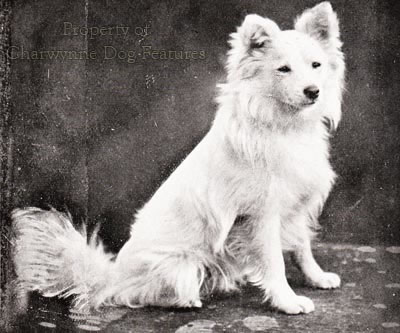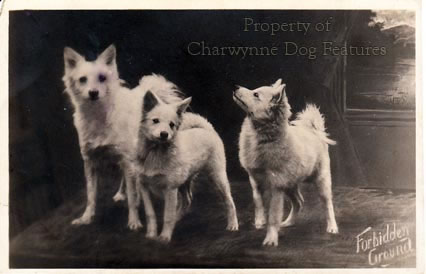650 Defining Beauty
DEFINING BEAUTY
by David Hancock

 The Gundog Group can lay claim to containing the most handsome collection of dogs of any group. The setters especially have a natural grace, beauty of form and absence of exaggeration which make them pleasing to the eye. Beauty of movement however doesn't always accompany such handsomeness. It is so disappointing to see and be ready to admire a startlingly good-looking setter only to groan when it starts to move. For me beauty of movement is inseparable from any judgement of handsomeness of appearance. It may well be that show ring gundogs are better looking than specimens of say two hundred years ago, but often only until they start to move. Spaniels too are bred more uniformly and prettier, but I do wish that Clumbers had to be presented in the show ring without the permittance in its breed standard of eyes which are 'slightly sunk' with 'some haw showing'. Red raw eyes are never pretty.
The Gundog Group can lay claim to containing the most handsome collection of dogs of any group. The setters especially have a natural grace, beauty of form and absence of exaggeration which make them pleasing to the eye. Beauty of movement however doesn't always accompany such handsomeness. It is so disappointing to see and be ready to admire a startlingly good-looking setter only to groan when it starts to move. For me beauty of movement is inseparable from any judgement of handsomeness of appearance. It may well be that show ring gundogs are better looking than specimens of say two hundred years ago, but often only until they start to move. Spaniels too are bred more uniformly and prettier, but I do wish that Clumbers had to be presented in the show ring without the permittance in its breed standard of eyes which are 'slightly sunk' with 'some haw showing'. Red raw eyes are never pretty. 
Many shooting men complain about excessive coat on a number of gundog breeds and I can see why. But in some pastoral breeds the sheer weight of coat now detracts from the beauty of the breed. The Rough Collie is required to have a coat which fits the outline of its body and is very abundant in the frill and mane, with profuse feathering above the hocks and a very profuse tail. I suspect that within my lifetime the Rough Collie's coat has doubled in length, which to me spoils the appearance of a distinctly handsome breed. The coat no longer fits the outline of the body, it drowns it. No dog could work with such a coat in the pastures. No shepherd would wish to own a dog with such a coat. For me this is a beautiful breed being slowly but surely ruined by its sheer weight of coat. No longer does the coat fit the outline of the body, as demanded by the breed blueprint; the physical beauty of this breed is in peril.
We have made the Pomeranian into a tiny dog. The production of a much tinier version is a matter of choice; my concern is the not the preference for the dwarf variety but the loss of the very beautiful larger one in so doing. The introduction of the Wolfspitz from Germany and the Japanese Spitz has to some extent filled this gap. But we cannot claim that the show ring is producing more beautiful dogs when the bigger Pomeranian is just allowed to disappear. In his Dogs since 1900 (Dakers 1950) Arthur Croxton Smith writes: "My own impression...is that they lost favour with the public as the dogs of medium size, such as people like for companions, were ousted by the tinies, which seem more in place in the show pen than anywhere." Perhaps the re-emergence of the bigger Pom would reinvigorate public interest in them as companion dogs. It was the larger Pom which attracted the interest of Queen Victoria and led to the breed being favoured in Britain. By withdrawing challenge certificates for dogs over 7lbs the Kennel Club robbed us of a beautiful dog.
When I look at depictions of Bull Terriers by Cecil Aldin, Maud Earl, John Ferneley senior and William Weekes and then compare those dogs with the egg-headed specimens of today, there is no doubt in my mind that we have substituted an ugly dog for a much more attractive one. Similarly if you look at Bulldog paintings by say Wright Barker in 1893, Arthur Heyer in 1890 and prints of around 1850 a far more appealing animal is revealed. Ben Marshall's Mastiff of 1799, Ben Herring's Mastiff portrayal of 1855 and Edwin Douglas's Collie of twenty years later show much more alluring specimens than we see today. Contemporary fanciers may well disagree but I wonder if this isn't because they are just conforming with modern fashion (and desiring to win with the altered breed type) rather than consciously favouring it.
It is time for the kennel clubs of the world to define what is meant by their declared mandate of improving dogs. Improving means producing something better. The Crufts catch-phrase of 'the best of the very best' is questionable without a definition of what the dogs exhibited are best at. I have no argument at all with the desire to produce handsome dogs but for me a beautiful dog has to have beauty of movement too. In a new century already dominated by animal welfare concerns, the word soundness should feature more prominently. 'Soundness before beauty' is a worthier claim; 'the soundest of the sound' is a more admirable slogan. A championship dog show has to be so much more than a beauty contest; it is a livestock show where future breeding stock is assessed. Writing three centuries ago, Alexander Pope penned these prescient perceptive words:
"Beauties in vain their pretty eyes may roll;
Charms strike the sight, but merit wins the soul."
Beauty does appeal to the eye and please the mind. But merit, that quality which justifies reward, does more, it lifts the spirit, satisfies the quest for high standards, truly 'wins the soul'. Beauty alone can never be enough, even at a dog show where physical perfection is aimed at, however impossible the task. When a handsome dog displays ugly movement it immediately ceases to be a beautiful dog to me. When a stunningly handsome dog reveals serious anatomical faults, on closer inspection, the charms which struck the sight soon trouble the mind. When you know that a strikingly good-looking dog carries hereditary flaws which will be passed on to its offspring, the mind should rebel and the soul take control. The beauty of a show exhibit, stacked for the judge's admiration, can be very temporary. Its genes and their accompanying faults and flaws are permanent. If dog shows are viewed merely as canine beauty contests, how can the merit of the breeding stock on display there ever be respected? The pursuit of beauty rather than soundness in subject living creatures tells you much more about human vanity than human wisdom.